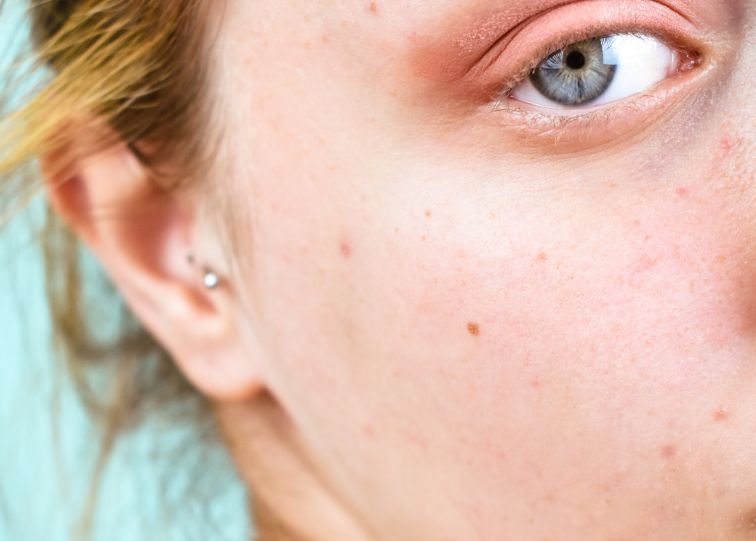
When we talk about glowing or glass skin, we usually picture a smooth, even surface that reflects light beautifully. But textured skin gets in the way of that ideal for many people. It’s more common than you might think and normal, but if it's something you’d like to improve, there are ways to smooth things out.
What Is Textured Skin?
Textured skin refers to any uneven skin surface. Instead of being soft and smooth to the touch, skin might feel bumpy, rough, dry, or patchy. Texture can show up as:
-
Enlarged pores
-
Rough patches or flakiness
-
Fine lines or wrinkles
-
Acne and acne scars
- Milia (tiny white bumps)
-
Uneven tone or dullness
Textured skin can be caused by a variety of factors, including genetics, sun damage, dehydration, a buildup of dead skin cells, or underlying skin conditions like acne or rosacea.
What Causes Skin Texture?
Here are some of the most common culprits:
-
Dead Skin Cell Buildup: Without regular exfoliation, dead cells can accumulate on the surface, making skin look dull or feel rough.
-
Sun Damage: UV exposure breaks down collagen and elastin, leading to premature aging and a leathery skin texture.
-
Acne and Inflammation: Breakouts and chronic inflammation can leave behind scars, bumps, or uneven tone.
-
Dehydration: Skin lacking moisture tends to feel tight, flaky, and textured.
-
Poor Skincare Habits: Over-cleansing, skipping SPF, or using the wrong products can disrupt your barrier and contribute to texture.
How to Fix Textured Skin
While there’s no overnight solution, consistent skincare can dramatically improve skin texture over time. Here’s how:
1. Exfoliate Regularly (But Gently)
Exfoliation helps remove the dead skin cells that contribute to roughness.
Chemical exfoliants like AHAs (glycolic or lactic acid) and BHAs (salicylic acid) dissolve dead cells and unclog pores.
Physical exfoliants (like scrubs) can help too, but they must be gentle harsh scrubbing can worsen texture and cause micro-tears.
Use a chemical exfoliant 1 to 3 times a week, depending on your skin type.
2. Use Retinoids
Retinoids like retinol or tretinoin increase cell turnover, unclog pores, fade discoloration, and smooth fine lines.
- Start slow 1 to 2 times per week, and build up as your skin adjusts.
- Pair with a nourishing moisturizer to avoid irritation.
Consider the Age Defying Liposomal Retinol Moisturizer, which uses 1 pure retinol and is designed to rejuvenate the skin and reduce signs of aging and texture. It also uses stem cell extracts, squalane, and peptides to give deep nourishment.
3. Hydrate & Strengthen the Skin Barrier
A healthy skin barrier is essential for smooth, supple skin.
Look for humectants like hyaluronic acid or glycerin to draw in moisture. Add emollients and ceramides to seal it all in and repair the barrier.
Layer a hydrating serum under a rich, barrier-repairing moisturizer. We recommend our StemPep Serum and StemPep Moisturizer, both are packed with patent-pending stem cell technology and use active ingredients to help deliver a natural and effective solution to strengthen the skin barrier.
4. Never Skip SPF
Sun protection is crucial. UV exposure worsens texture and accelerates aging.
Choose a broad-spectrum sunscreen (SPF 30 or higher) and wear it daily, rain or shine.
Mineral sunscreens are a great option for sensitive or acne-prone skin.
5. In-Office Treatments (For Stubborn Texture)
If topical skincare isn’t enough, professional treatments can help:
- Microneedling to boost collagen
-
Chemical peels for deeper exfoliation
- Laser resurfacing to smooth scars or wrinkles
-
Facials are designed for resurfacing and hydration
Always consult with a dermatologist or licensed esthetician to find the right option for your skin type.
Final Thoughts
Textured skin is completely normal but if you’re looking to improve it, consistency is key. The combination of exfoliation, hydration, retinoids, and sun protection can make a major difference over time. And remember: healthy skin isn’t perfect, it’s just cared for.


